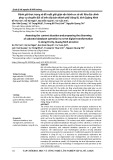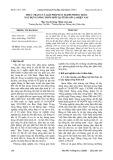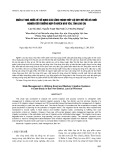
Int.J.Curr.Microbiol.App.Sci (2020) 9(11): 1692-1698
1692
Original Research Article https://doi.org/10.20546/ijcmas.2020.911.202
Impact of Cluster Frontline Demonstrations on Yield, Knowledge Adoption
and Spread of Blackgram in Tribal Belt of Rajasthan
Subhash Aswal, Sunil Kumar*, D. K. Singh, T. C. Verma,
K. C. Meena and Pappu Khatik
Krishi Vigyan Kendra, Anta, Baran, Agriculture University, Kota (Rajasthan), India
*Corresponding author
A B S T R A C T
Introduction
Blackgram (Vigna mungo) is one of the
important Indian origin pulse crop. The
important states that cultivates blackgram are
Madhya Pradesh, Maharashtra, Andhra
Pradesh, Tamil Nadu, Uttar Pradesh, Orissa
and Rajasthan etc. In Rajasthan area under
blackgram is 2.78 lakh ha with a production
of 1.46 lakh tonnes and productivity of 523 kg
ha-1 (Commission rate of Agriculture,
Rajasthan, 2017-18). The most promising
feature of blackgram is rich in protein content
and their ability to fix atmospheric nitrogen. It
has been reported that black gram produces
22.10kg N ha-1yr-1 which supplements 59
thousand tons of urea annually (Jat et al.,
2017).
It is an important pulse crop grown during the
month of June-July in the Hadauti region of
Rajasthan. It is the second most important
crop after soybean during kharif season in this
region. Mostly it has grown in rainfed
conditions, after its harvest farmer’s mostly
growing wheat, mustard and chickpea under
irrigated conditions while fallow in rainfed
conditions. The Baran district area under
International Journal of Current Microbiology and Applied Sciences
ISSN: 2319-7706 Volume 9 Number 11 (2020)
Journal homepage: http://www.ijcmas.com
Cluster front line demonstrations were conducted in Shahabad and Kishanganj
block of Baran district of Rajasthan by Krishi Vigyan Kendra, Baran during 2012-
13 to 2018-19. The total 505 demonstrations were laid out on 198 ha area of
farmer's field as per recommended package of practices of Agriculture University,
Kota. The farmers practice was considered as control plot in demonstration
cluster. A significant enhancement in the yield of blackgram was recorded over
the control by 32.78, 37.65, 47.31, 24.43, 41.30, 23.15 and 22.68 percent for the
year 2012-13, 2013-14, 2014-15, 2015-16, 2016-17, 2017-18 and 2018-19,
respectively. The overall adoption level of blackgran production technology was
increased due to cluster front line demonstrations. The local variety replaced by
PU – 31in demonstration area and covered 90.23 per cent blackgram area of the
Baran district.
K e y w o r d s
Adoption level,
Blackgram, Cluster
front line
demonstrations,
Horizontal spread,
Package of
practices, PU – 31
Accepted:
12 October 2020
Available Online:
10 November 2020
Article Info

Int.J.Curr.Microbiol.App.Sci (2020) 9(11): 1692-1698
1693
blackgram is 15502 ha with a production of
9238 tonnes and productivity of 596 kg ha-
1.The poor yield of blackgram is mainly
attributed to the use of poor quality seeds,
water stress, no fertilizer application, no
YMV management and no weed management
(Meena et al., 2018 and Kumar et al., 2018).
The reason of low productivity also may be
attributed to non-adoption of improved
production technology which includes the
agronomic practices and socio-economic
conditions of the tribal peoples. The
productivity of blackgram in the district can
be increase by fallowing the appropriate
agronomic practices along with high yielding
blackgram varieties.
Therefore, it is very essential to demonstrate
the high yielding varieties, resistant to biotic
and abiotic stresses and improved production
technologies which the farmers generally do
not adopt.
An effort was made by the KVK scientists by
introducing the new agro techniques through
cluster front line demonstrations (CFLDs).
The CFLDs were conducted on blackgram
(var. PU – 31) by KrishiVigyan Kendra,
Baran on farmers field during seven
consecutive years in kharif seasons from
2012-13 to 2018-19.
Materials and Methods
The study was conducted in Kishanganj and
Shahabad Block of Baran district in the
Rajasthan state. The Kishanganj and
Shahabad block is located at 26.0982° N,
87.9450° E and 27.6441° N, 79.9447° E,
latitude and longitude, respectively. To make
crop diversification, Krishi Vigyan Kendra,
Baran had conducted the CFLDs on pulse
crops during 2012-13 to 2018-19. Before
organizing actual CFLDs, the KVK scientists
had collected baseline information from two
adopted villages in the year 2012. During
2012-13 to 2018-19, KVK had organized
CFLDs of Blackgram on 198.0 ha area. The
CFLDs had organized on farmers’ field
according to the package of practices
recommended by Agriculture University,
Kota. The farmer practice was considered as
local check in demonstration cluster. These
control plots were maintained by the farmers
according to their own traditional cultivation
practices. The KVK scientists had provided
critical inputs such as seed, seed treatment,
herbicides, micro nutrients, IPM and bio-
pesticides to the farmers for demonstration
plots.
The demonstrations were laid out under the
close supervision of KVK scientists. Total
505farmers were selected for the conducting
of CFLDs on blackgram. Therefore, 505
beneficiary farmers were selected purposively
as the samples for present investigation. The
study was conducted in experimental designs
(‘Control-Treatment’ and ‘Before-After’) of
social research. The yield data of
demonstration plots as well as control plots
were collected immediately after harvesting to
assess the impact of CFLDs intervention on
the yield of blackgram (2012-13 to 2018-19).
However, structured and pre-tested interview
schedule was used to elicit the information
from beneficiary farmers about adoption,
varietal replacement and horizontal spread of
pulse crop technologies in adopted villages.
The personal interview was conducted with
the beneficiary farmers after the completion
of each year. The following formulae were
used to assess the impact of CFLDs on the
different parameters of blackgram crops.
Impact on Yield (%
Change)
Yield of Demonstration Plot (kg ha-1) – Yield of
Control Plot (kg ha-1)
× 100
Yield of Control Plot (kg ha-1)
Impact on Adoption
(% Change)
No. of Adopters after Demonstration – No. of
Adopters before Demonstration
× 100
No. of Adopters before Demonstration

Int.J.Curr.Microbiol.App.Sci (2020) 9(11): 1692-1698
1694
Results and Discussion
Impact of CFLDs on Crop Yield
The finding of the impact of CFLDs on yield
enhancement of blackgram is presented in this
part. It is evident from table 1 that the average
yield of seven years of demonstration plot of
blackgram ‘PU – 31’ variety was 949 kg ha-
1over the control plot yield 714 kg ha-1during
2012-13 to 2018-19.This showed that there
was a positive and significant increase in the
mean yield of blackgram demonstration plots
over the farmer practice by 32.78, 37.65,
47.31, 24.43, 41.30, 23.15 and 22.68 per cent
for the year 2012-13, 2013-14, 2014-15,
2015-16, 2016-17, 2017-18 and 2018-19,
respectively. The main reasons of the low
yield of blackgram control plots in adopted
villages were the use of poor quality seeds,
traditional cultivation methods with poor
nutrient, weed, insect and pest management
practices. However, KVK scientists had used
improved varieties of blackgram, seed
treatment with carbendazim50WP @ 2.0
g/kg, adopted improved agronomic practices
for demonstration plots that resulted32.76%
higher mean yield over a control plot mean
yield. This finding is in agreement with the
findings of Singh et al., (2019).
This improvement in yield might be due to
use of treated seed of improved variety PU –
31, use of bio-fertilizers, timely sowing,
application of recommended dose of
fertilizers, proper and timely weed
management and integrated pest management
practices. Similar observations were noted at
by Krishi Vigyan Kendra, Champaduring
2016-17 with the introduction of crop
production technologies through frontline
demonstrations (Sahu et al., 2018). Sahare et
al., (2018) in Umaria, Madhya Pradesh also
recorded similar results in blackgram as per
the mean of five consecutive years (2009-10
to 2013-14).
Impact of CFLDs on adoption of
blackgram production technologies
Data on adoption of blackgram production
technologies by the beneficiary farmers are
presented in table 2. It was found that a
number of adopters for improved variety (PU
– 31) and seed rate of 18 kg ha-1 of blackgram
were 3.96% before demonstrations, which
increased to 100.00% after cluster frontline
demonstrations in adopted villages. A similar
trend was also observed in the case of weed
management practices as an increase in the
percentage of adopters from 27.03 to 95.25%.
The number of adopters for application of N:
P: Zinc sulphate (20:40:25 kg ha-1) fertilizers
and insect management by using pesticide viz.
Dimethoate 30% EC 1.0 l ha-1/
Thiamethoxam 25% WG @200 g ha-1were
increased significantly during pre and post-
demonstrations period from 16.28 to 85.15%
and from 33.65 to 83.56%, respectively. The
cercospora leaf spot diseases infestation were
found due to continuous heavy rainfall and
high relative humidity at reproductive stage
which controlled by carbendazim 50WP @
500 g ha-1.
Number of adopters for disease control was
14.91% before demonstrations, which
increased to 73.07% after cluster front line
demonstrations. In this line, it was found that
majority of the participant farmers in CFLDs
program had full adoption of improved
practices viz., land preparation, use of high
yielding varieties, sowing time and
application of manures and fertilizers. These
results are in close conformity with the
findings recorded in the same crop (Sahare et
al., 2018). Significant difference was
observed between the adoption of CFLDs
beneficiary farmers and non-beneficiary
farmers towards blackgram production
technology.

Int.J.Curr.Microbiol.App.Sci (2020) 9(11): 1692-1698
1695
Table.1 Impact CFLDs on yield of blackgram
Year
Technology Interventions
Demo.
Area (ha)
No. of
Farmers
Average yield (kg ha-1)
Impact
(%
Change)
Control
(kg ha-1)
Demo.
(kg ha-1)
2012-13
PU – 31 variety @ 18 kg/ha; ST carbendazim50WP @ 2.0 g kg-1; Fertilizers: N,
P & Zinc sulphate @ 20: 40 & 25 kg ha-1; Herbicide: Imazethapyr 10% SL @
55 g a.i. ha-1 at 15-20 DAS & Insecticide: Dimethoate 30% EC 1.0 l ha-1
20.0
50
961
1276
32.78
2013-14
PU – 31 variety @ 18 kg/ha; ST Carbendazim 50WP @ 2.0 g kg-1; Fertilizers:
N, P & Zinc sulphate @ 20: 40 & 25 kg ha-1; Herbicide:Imazethapyr 10% SL @
55 g a.i. ha-1 at 15-20 DAS & Insecticide: Dimethoate 30% EC 1.0 lha-1
20.0
50
850
1170
37.65
2014-15
PU – 31 variety @ 18 kg/ha; ST Carbendazim 50WP @ 2.0 g kg-1; Fertilizers:
N, P & Zinc sulphate @ 20: 40 & 25 kg ha-1; Herbicide: Imazethapyr 10% SL
@ 55 g a.i.ha-1 at 15-20 DAS & Insecticide: Dimethoate 30% EC 1.0 l ha-1
40.0
110
501
738
47.31
2015-16
PU – 31 variety @ 18 kg/ha; ST Carbendazim 50WP @ 2.0 g kg-1; Fertilizers:
N, P & Zinc sulphate @ 20: 40 & 25 kg ha-1; Herbicide: Imazethapyr 10% SL
@ 55 g a.i.ha-1 at 15-20 DAS & Insecticide: Dimethoate 30% EC 1.0 l ha-1
8.0
20
614
764
24.43
2016-17
PU – 31 variety @ 18 kg/ha; ST Carbendazim 50WP @ 2.0 g kg-1; Fertilizers:
N, P & Zinc sulphate @ 20: 40 & 25 kg ha-1; Herbicide:Imazethapyr 10% SL @
55 g a.i. ha-1 at 15-20 DAS & Insecticide: Dimethoate 30% EC 1.0 lha-1
20.0
50
787
1112
41.30
2017-18
PU – 31 variety @ 18 kg ha-1; ST Carbendazim 50WP @ 2.0 g kg-1; Fertilizers:
N, P & Zinc sulphate @ 20: 40 & 25 kg/ha; Herbicide:Imazethapyr 10% SL @
55 g a.i. ha-1 at 15-20 DAS, Insecticide: Dimethoate 30% EC 1.0 l ha-
1&Cercospora leaf - Carbendazim 50WP @ 500 g ha-1.
50.0
125
920
1133
23.15
2018-19
PU – 31 variety @ 18 kg ha-1; ST Carbendazim 50WP @ 2.0 g kg-1; Fertilizers:
N, P & Zinc sulphate @ 20: 40 & 25 kgha-1; Herbicide:Imazethapyr 10% SL @
55 g a.i. ha-1 at 15-20 DAS, Insecticide: Thiamethoxam 25% WG @200 g
ha&Cercospora leaf - Carbendazim 50WP @ 500 g ha-1.
40
100
366
449
22.68
Total/ Average
198
505
7.14
9.49
32.76

Int.J.Curr.Microbiol.App.Sci (2020) 9(11): 1692-1698
1696
Table.2 Impact of CFLDs on adoption of blackgram production technologies
S.
No.
Technology
Number of Adopters (N=505)
Change in No.
of adopters
Impact
(% Change)
Before
demonstration
After
demonstration
1.
Improved variety: PU – 31 & Seed rate @ 18 kg ha-1
20 (3.96)
505 (100.00)
+ 485
2425.00
2.
Seed treatment:Carbendazim 50WP @ 2.0 g kg-1
40 (10.10)
396 (78.42)
+ 356
890.00
3.
Spacing: 30×10 cm
25 (6.17)
405 (80.20)
+ 380
1520.00
4.
Nutrient management: N: P:K: Zinc sulphate @ 20: 40:25
kg ha-1
70 (16.28)
450 (85.15)
+ 360
542.86
5.
Weed management: Imazethapyr 10% SL @ 55 g a.i. ha-1
at 15-20 DAS
130 (27.03)
481 (95.25)
+ 351
270.00
6.
Insect management: Dimethoate 30% EC 1.0 l ha-1/
Thiamethoxam 25% WG @200 g ha-1
142 (33.65)
422 (83.56)
+ 280
197.18
7.
Disease management (Cercospora leaf spot):
Carbendazim 50WP @ 500 g ha-1.
55 (14.91)
369 (73.07)
+ 314
570.91
* Figures in parentheses indicate percentage Source: Field survey of 2018-19
Table.3 Impact of CFLDs on horizontal spread of PU – 31 variety of blackgram in the district
S.
No.
Year
Area (ha) ofblackgram in district
Area (ha) of PU 31
after demonstration
% share of PU 31 after
demonstration
1.
2012-13
5429
20
0.37
2.
2013-14
1212
102
8.42
3.
2014-15
6662
1105
16.59
4.
2015-16
20897
11004
52.66
5.
2016-17
43308
36300
83.82
6.
2017-18
136502
119901
87.84
7.
2018-19
104211
94033
90.23







![Giáo trình Đánh giá nông thôn (Nghề Phát triển nông thôn Trung cấp) - Trường Cao đẳng Cộng đồng Đồng Tháp [Mới nhất]](https://cdn.tailieu.vn/images/document/thumbnail/2022/20221012/troinangxanh10/135x160/5011665566145.jpg)

![Giáo trình Kỹ năng giao tiếp Phát triển nông thôn Trung cấp - Trường Cao đẳng Cộng đồng Đồng Tháp [Chuẩn nhất]](https://cdn.tailieu.vn/images/document/thumbnail/2022/20221012/troinangxanh10/135x160/8251665566184.jpg)
















